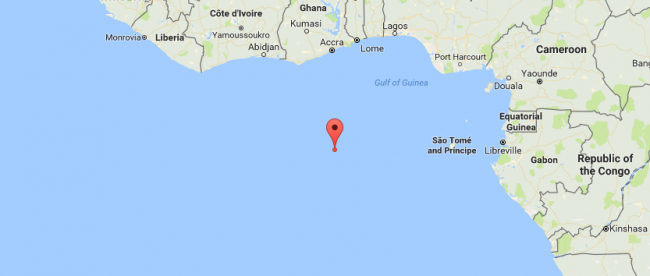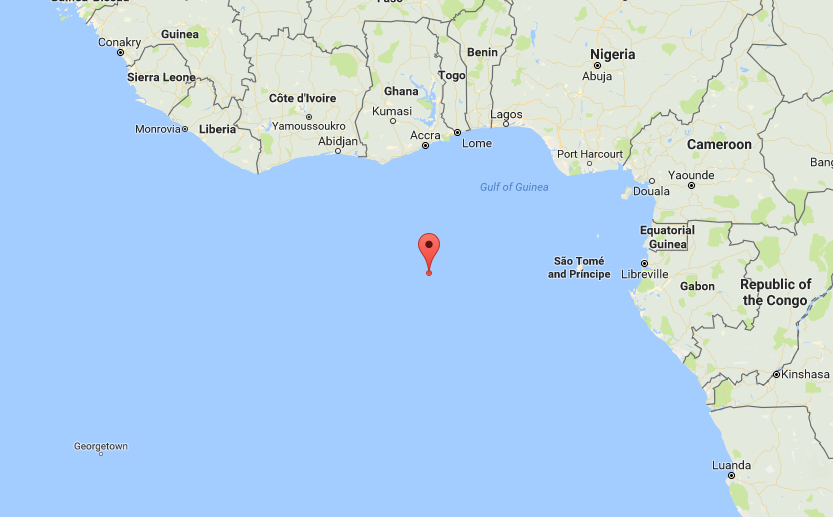There’s No Place Like 0,0


The flag on the map pictured above is in the middle of nowhere, colloquially speaking. But in another sense, that flag is in the middle of right here, no matter who you are or where you are. How so? Because it’s the middle of the Earth, at least by latitude and longitude. It’s at 0° north, 0° east — where the Prime Meridian and the Equator cross.
And it’s also home to Null Island, a one-meter square island. And you’ve probably been there — or, at least, your phone has.
To understand why, we first have to address the idea of “geocoding.” Geocoding, basically, is the process of taking a point on the Earth and describing it by a pair of numbers — the latitude and longitude. Latitudes north of the Equator are positive while those south are represented with a negative number; longitudes east of the Prime Meridian are positive, those west are negative. If you enter coordinates 40.6892494, -74.0445004 into Google or Google Maps, for example, you’ll be brought to the Statue of Liberty. (On a map. You won’t be teleported.)
Sometimes, though, something goes wrong in the geocoding process. The reasons for these errors can be as simple as a typo or so complex that you probably need to be a cartographer to understand it. Regardless, mistakes happen and as a result, geocoding data is sometimes omitted from a data set. And missing data can throw off a computer — at times, systems don’t know whether to represent that missing data with nothing or with a zero. Imagine, for example, that you take a picture with your phone, but the phone doesn’t know where you are. It will tag that photo with null values for both latitude and longitude — which is fine until another computer tries to read that data. A properly-designed piece of software will read the null data as “I don’t know,” but an improperly made one sees it as “0,0.” And that error will lead it to place the photo about 1,000 miles off the shore of Africa.
That’s a glitch, and a pretty common one — you may have experienced it momentarily in a variety of different apps, especially early versions of ones involving geolocation, such as Waze or Pokemon Go. But it can be more serious, too. In 2012, Wisconsin’s voter rolls were missing a lot of location data — while people were registered to vote, their addresses weren’t properly recorded. Instead, as a county clerk told the Milwaukee Journal-Sentinel, “We had many, many voters who showed up (on the computer map) on the coast of Africa and we had to drag them back to the state of Wisconsin and put them where they belonged.”
But more accurately, these voters were living on Null Island. Okay, Null Island doesn’t really exist — except for in map-making software. The concept of Null Island was created, at least — in or around 2001. As the Library of Congress notes, the history of this fictitious land isn’t well documented, but its purpose is generally agreed upon: “Null Island was intended to help analysts flag errors in a process known as ‘geocoding.'” By putting a name to this mysterious place off the African coast, the cartography community made it easier to identify and discuss the error.
Again, though, there’s no such thing as Null Island. That point and its immediate surroundings aren’t entirely empty, though; there’s a weather buoy, seen here, moored on the spot.
Bonus fact: While the Equator is defined scientifically — it’s the great circle created by the axis around which the Earth revolves — the Prime Meridian’s location is arbitrary. The location for the Prime Meridian was decided in 1884, when delegates from 25 nations gathered in Washington D.C. to discuss and vote on the very issue. The group — by a 22-1 vote with two abstentions — decided to have it run through Greenwich, England. The country now known as the Dominican Republic was the lone “no” vote, supporting the French who objected (but, with Brazil, abstained) with the decision to place the line there.
From the Archives: Null is Void: What happens when your last name is “Null”? Sometimes, the Internet becomes a difficult place to navigate.
Related: Null, a mixed media work by Jean Baptiste Apuatimi, in Amazon’s fine art collection. Yes, you can buy $4,000 works of art from the same website that you can buy $5 in toothpicks.
